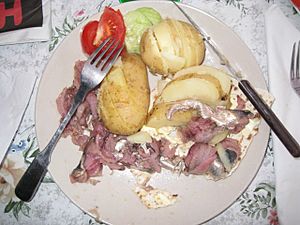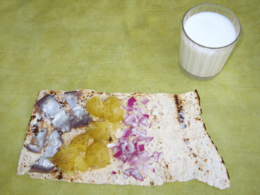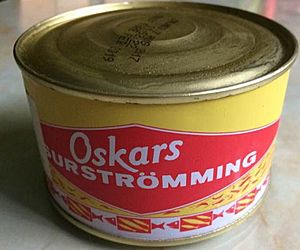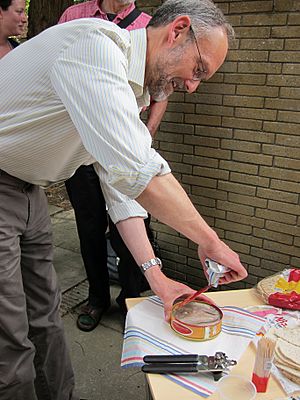Surströmming facts for kids

Opened can of surströmming in brine
|
|
| Alternative names | Fermented herring |
|---|---|
| Type | Fermented fish |
| Place of origin | Sweden |
| Region or state | Norrland |
| Invented | 16th century or earlier |
| Serving temperature | Cold |
| Main ingredients | Baltic herring Water Salt |
| Other information | Annual premiere the third Thursday in August. |
Surströmming (which means 'sour herring' in Swedish) is a traditional Swedish food. It's made from Baltic herring that has been lightly salted and fermented. People in Sweden have been eating it for a very long time, since at least the 16th century. It's important not to confuse surströmming with other fish dishes like fried herring or pickled herring.
The fish used for surströmming is called strömming in Swedish. This Baltic herring is smaller than the Atlantic herring found in the North Sea. Strömming usually refers to herring caught in the slightly salty waters of the Baltic Sea, north of the Kalmar Strait. These special herring are caught in April and May, just before they lay their eggs.
To make surströmming, just enough salt is added to the raw herring. This stops the fish from rotting but allows it to ferment. This fermentation process takes at least six months. It gives the fish a very strong smell and a slightly sour taste. When a new can of surströmming is opened, it has one of the strongest food smells in the world!
Years ago, in the 1940s, surströmming makers in Sweden asked for a special rule. This rule would stop fish that wasn't fully fermented from being sold. So, a rule was made that said the new year's surströmming couldn't be sold before the third Thursday in August. Even though this rule isn't official anymore, shops still wait until this date for the "premiere" of the new catch.
Contents
What is the History of Surströmming?
Surströmming has been a part of northern Swedish cooking since at least the 1500s.
Making fish last longer through fermentation is a very old way of cooking in Europe. The oldest signs of fermented fish were found in what is now southern Sweden. These findings are about 9,200 years old! Other examples include garum, a fermented fish sauce from ancient Greece and Rome. Even Worcestershire sauce today has a fermented fish ingredient.
People might have started fermenting fish in weak salt water because salt was very expensive a long time ago. This method helped them save fish without using too much salt. Today, the fish are first soaked in strong salt water to remove blood. Then, they ferment in weaker salt water in barrels before being put into cans.
Putting the fish into cans started in the 1800s. This made it easier to sell surströmming in shops and store it at home. Before canning, the fish was kept in large wooden barrels or smaller kegs. Canning also helped surströmming be sold further south in Sweden.
How Does Surströmming Ferment?
The fermentation process in surströmming is called autolysis. It starts with a special lactic acid enzyme found in the fish's spine. This enzyme, along with bacteria, creates strong-smelling acids. These acids include propionic acid, butyric acid, and acetic acid. Also, hydrogen sulfide is made, which smells like rotten eggs.
The salt in the water makes it hard for bacteria that cause rotting to grow. Instead, special bacteria called Halanaerobium bacteria grow well. These bacteria break down the fish's natural sugars into organic acids. This is what makes the fish sour.
How is Surströmming Made and Sold?
The herring are caught in April and May. This is when they are in their best condition and just about to lay eggs. First, they are put into a strong salt water for about 20 hours to remove blood. Then, their heads are removed, and they are cleaned. After that, they go into a weaker salt water solution.
The barrels of fish are kept in a room with a controlled temperature, around 15–20 degrees Celsius (59–68 degrees Fahrenheit). The fish are put into cans starting in early July and for about five weeks after that. About ten days before the "premiere" day in August, the finished cans are sent to stores.
The fermentation depends on the lactic acid enzyme in the fish's spine. This enzyme works best with the right temperature and salt levels. The cool temperatures in Northern Sweden are important for how the final product tastes and smells.
Before modern canning, surströmming was sold in wooden barrels. It had to be eaten right away because even small barrels could leak.
The fermentation keeps going inside the can. This is why the cans often bulge out. Normally, a bulging can of food would mean it's spoiled or has botulism. But for surströmming, it's normal! The Halanaerobium bacteria inside the can make carbon dioxide gas. They also create the unique smells: pungent (from propionic acid), rotten-egg (from hydrogen sulfide), rancid-butter (from butyric acid), and vinegary (from acetic acid). Because of these gases, a thousand cans of surströmming exploded during a warehouse fire in Sweden in 2014.
Surströmming is sold in grocery stores all over Sweden. In 2009, about 2 million people ate surströmming each year. Only a tiny amount, 0.2 percent, of all surströmming made in Sweden is exported to other countries.
Not everyone likes surströmming. It's a food that people either love or strongly dislike, much like another Swedish dish called lutefisk.
How Do People Eat Surströmming?


Swedes usually eat surströmming after the third Thursday of August, which is known as "Surströmming day." They continue to eat it through early September. Because of its very strong smell, people often eat it outdoors. The can is usually opened far from the dining table. Sometimes, people even open it underwater in a bucket. This helps stop the gas from spraying the salty liquid.
Surströmming comes in two ways: with just the heads removed, or as fillets. If it's not filleted, people clean the fish before eating it. They remove the backbone and sometimes the skin. The fish eggs (roe) are often eaten with the fish.
Surströmming is often eaten with tunnbröd, a thin, soft or crispy bread. This tradition started in the High Coast area of Sweden. There, people make a sandwich called a surströmmingsklämma. It uses two pieces of buttered hard tunnbröd. Besides the fish, the most common toppings are potatoes (sliced or mashed, often almond potatoes) and finely chopped red onion. Some people also eat surströmming without bread, just with the other ingredients. To balance the strong taste, Västerbotten cheese is sometimes added.
In southern Sweden, people use different toppings. These include diced red onion, gräddfil (a type of sour cream), crème fraîche, chives, and sometimes even tomato and chopped dill.
Surströmming is often served with snaps (a type of alcoholic drink), light beers like pilsner or lager, svagdricka (a type of small beer), water, or cold milk. What to drink with surströmming is a topic of debate among experts! Surströmming is usually the main food at a traditional party called a surströmmingsskiva.
Why is Surströmming Sometimes Controversial?
A German food writer named Wolfgang Fassbender once joked that the hardest part of eating surströmming is trying not to throw up before the first bite!
Surströmming and EU Rules
Because surströmming is made from herring from the Baltic Sea, it contains higher levels of certain chemicals like dioxins and PCBs. These levels are higher than what the EU usually allows. Sweden was given special permission for this from 2002 to 2011. They then asked for this permission to be renewed. Producers said that if the request was denied, they would only be allowed to use herring smaller than 17 centimeters (about 6.7 inches). These smaller fish have lower chemical levels, but it would affect how much surströmming could be made.
The Surströmming Challenge Online
Surströmming has become famous as one of the world's smelliest foods. This has led to many "challenge" videos on YouTube and other websites. In these videos, people who have never tried the food open a can for the first time. They often have very strong reactions, like gagging, swearing, holding their nose, or even throwing up. People criticize these videos because they often don't follow the right way to prepare surströmming. This includes opening the can outdoors or underwater, cleaning the fish, and serving it with tunnbröd and other toppings.
A German Eviction Story
In 1981, a landlord in Germany kicked out a tenant without warning. This happened after the tenant spilled surströmming liquid in the apartment building's stairwell. When the landlord went to court, the court agreed that the eviction was fair. The landlord's lawyers showed the court how bad the smell was by opening a can of surströmming right there! The court decided that "the disgusting smell of the fish brine far exceeded the degree that fellow-tenants in the building could be expected to tolerate."
Airline Bans on Surströmming
In April 2006, several big airlines, like Air France, British Airways, and KLM, banned surströmming. They said the pressurized cans of fish could possibly explode. After this, the fish was no longer sold at Stockholm's international airport. The people who make surströmming called the airlines' decision "culturally illiterate." They said it's a "myth that the tinned fish can explode."
Protests in Hong Kong
In March 2018, during elections in Hong Kong, an official had disqualified two candidates. One of the candidates, Ventus Lau, visited a government office. He brought a can of surströmming and opened it in public. Lau said he wanted the official to understand that the people of Hong Kong felt their election system was "rotten." Lau later appealed to the court, and the court ruled that the official's decisions were not fair.
Where Can You Learn More About Surströmming?
On June 4, 2005, the world's first surströmming museum opened. It's called "Fiskevistet" (which means 'The Fish Encampment'). You can find it in Skeppsmalen, about 20 kilometers (12 miles) south-east of Örnsköldsvik, a town at the northern end of the High Coast in Sweden.
Images for kids
See also
 In Spanish: Surströmming para niños
In Spanish: Surströmming para niños








